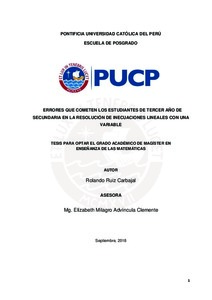Errores que cometen los estudiantes de tercer año de secundaria en la resolución de inecuaciones lineales con una variable
Abstract
La presente investigación tiene como objetivo analizar los errores que cometen los
estudiantes de tercer año de educación secundaria de la I.E. “Fe y Alegría n.° 37 en
la resolución de inecuaciones lineales con una variable. Como nuestro estudio está
centrado en el análisis de errores, planteamos la siguiente pregunta de investigación:
¿Cuáles son los errores que cometen los estudiantes de tercer año de educación
secundaria de la I.E. “Fe y Alegría” n.° 37 en la resolución de inecuaciones lineales
con una variable?.
Para este estudio, utilizamos la clasificación de errores elaborada por el autor de la
tesis, que nos permitió analizar los errores que cometen los estudiantes de tercer año
de educación secundaria en la resolución de inecuaciones lineales. Esta clasificación
de errores fue elaborado tomando como marco teórico el Enfoque Lógico Semiótico
(ELOS) propuesto por Socas (1979) y la clasificación de errores propuesta por los
siguientes autores: Radatz (1979), Mosvshovitz-Hadar, Zaslavsky e Inbar (1987),
Esteley y Villarreal (1990,1996), Astolfi (2000), Brousseau (2001), Caputo y Macías
(2006), Abrate, Pochulu y Vargas (2006), Saucedo (2007). Podemos concluir que los
estudiantes cometen errores muy frecuentes de acuerdo a la tipología de errores
planteadas en el siguiente orden: por no lograr comprender y traducir una expresión
matemática (lenguaje literal, representación algebraica y representación gráfica) a
otra; por el desconocimiento teórico y dominio de fórmulas y propiedades; por no
comprender los símbolos y términos matemáticos de desigualdad (<,>,≤,≥) e intervalos ([],<>) y su relación entre ellos; cometen errores en el procedimiento o
de cálculo elemental; por no tener los conocimientos previos; por realizar inferencias
inadecuadas en el razonamiento lógico y por no verificar sus resultados. The current research has as objective to analyze the error that our third-year students
commit in 37 “Fe y Alegría” high school. Like Our study is focused on the analysis of
error, we propose the following research question:What is the error that our third year
students make at "37 Fe y Alegría" high school about the resolution of linear
inequations with a variable?. For this study, we use the classification of error that it
was made by the tesis author for the analysis of the error high school student in the
resolution of linear inequations. This classification of errors was elaborated taking into
account as theoretical framework of The Semiotic Logical Approach (ELOS) Proposed
by Socas (1979) and the classification of error proposed by the following authors:
Radatz (1979), Mosvshovitz-Hadar, Zaslavsky and Inbar (1987), Esteley and Villarreal
(1990,1996), Astolfi, (2000), Brousseau (2001), Caputo and Macías (2006), Abrate,
Pochulu and Vargas (2006), Gladis Saucedo (2017). We can conclude that students
make very frequent mistakes according to the errors presented in the following order:
for not being able to understand and traslate a mathematical expression (literal
language, algebraic representation and graphic representation) to another; by the
theoretical ignorance and domain of formulas and properties; for not understanding the
mathematical symbols and terms of inequality and intervals and their relation between
them; they make mistakes in the procedure or elementary calculation; for not having
the previus knowledge; for making inadequate inferences in logical reasoning and for
not veryfying their results.
Temas
Matemáticas--Estudio y enseñanza
Resolución de problemas
Matemáticas--Problemas, ejercicios, etc.
Educación secundaria--Perú--Lima
Educación pública--Perú--Lima
Resolución de problemas
Matemáticas--Problemas, ejercicios, etc.
Educación secundaria--Perú--Lima
Educación pública--Perú--Lima
Para optar el título de
Maestro en la enseñanza de las Matemáticas
Collections
The following license files are associated with this item:






